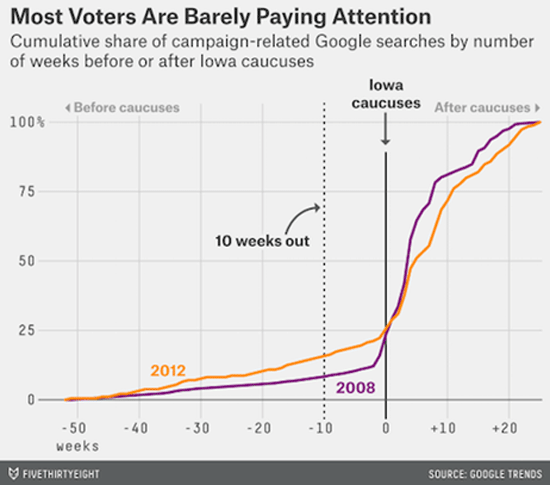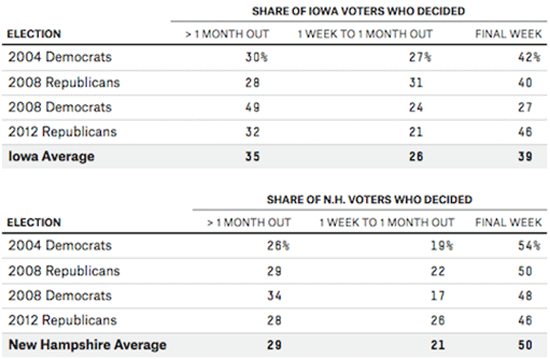Iím going to offer something a little different in this weekís Outside the Box. Nate Silver has consistently been one of the best political analysts of the past 12 years. I wasnít terribly enamored of his move from the New York Times to ESPN Ė to go back to covering sports rather than politics Ė but he still covers politics over at 538.
This past week he wrote an article called ďDear Media, Stop Freaking Out About Donald Trumpís Polls.Ē Itís not that heís got an anti-Trump bias, but he points out in this insightful article that polls taken this month arenít really telling us anything, and at the end of the piece he shows us what the breakdown of people who are firmly decided on their presidential candidate probably is for Iowa and New Hampshire. If nothing else, that will either make you happy because your favorite guy or gal may not actually be that far behind (assuming youíre Republican, that is) or it will demonstrate the dubious value not just of political polls but also of consumer and economic surveys as opposed to hard facts.
Silverís analysis speaks to the skeptic in me. In his analysis, Donald Trump still comes in at the top of the heap of announced candidates, but ďundecidedĒ is a massive winner. That wonít be the case on February 1 when the Iowa caucuses are actually held, and Nate discusses how and when people actually make decisions on such things. If you are like me and find yourself faced with the choices given us today, you may be (1) overwhelmed and (2) not exactly sure who to support. There is a lot to like about a lot of them, but the choice is confusing to say the least. Do you pick the candidate you think can do best in November, or do you pick the candidate you would really like to be president? I think you will find this a fun and interesting read.
Even though I am not traveling, I seem to stay just as busy as ever. I am beginning to whittle my inbox down while trying to keep up on my book research. When you start trying to write a book on what the world will look like in 20 years, there are just so many moving parts. We are also dealing with well over 100 different research assistants, and trying to coordinate all that and hit writing deadlines does make for a full day. An interesting day to be sure, but full.
You have a great week and be sure to check your inbox for my letter this week. It will have a major announcement that I am sure will intrigue you.
Your skeptical about polls in general analyst,
Sign-Up to Receive Outside the Box
Each week, John Mauldin highlights a thoughtful, provocativeessay from a fellow analyst or economic expert. Some will inspire you. Some will make you uncomfortable. All will challenge you to think outside the box.
Each day, you get the three tech news stories with the biggest potential impact.
Dear Media, Stop Freaking Out About Donald Trumpís Polls
By Nate Silver
Originally published on FiveThirtyEight.com, Nov. 23, 2015
Lately, pundits and punters seem bullish on Donald Trump, whose chances of winning the Republican presidential nomination recently inched above 20 percent for the first time at the betting market Betfair. Perhaps the conventional wisdom assumes that the aftermath of the terrorist attacks in Paris will play into Trumpís hands, or that Republicans really might be in disarray. If so, I can see where the case for Trump is coming from, although Iíd still say a 20 percent chance is substantially too high.
Quite often, however, the Trumpís-really-got-a-chance! case is rooted almost entirely in polls. If nothing Trump has said so far has harmed his standing with Republicans, the argument goes, why should we expect him to fade later on?
One problem with this is that itís not enough for Trump to merely avoid fading. Right now, he has 25 to 30 percent of the vote in polls among the roughly 25 percent of Americans who identify as Republican. (Thatís something like 6 to 8 percent of the electorate overall, or about the same share of people who think the Apollo moon landings were faked.) As the rest of the field consolidates around him, Trump will need to gain additional support to win the nomination. That might not be easy, since some Trump actions that appeal to a faction of the Republican electorate may alienate the rest of it. Trumpís favorability ratings are middling among Republicans (and awful among the broader electorate).
Trump will also have to get that 25 or 30 percent to go to the polls. For now, most surveys cover Republican-leaning adults or registered voters, rather than likely voters. Combine that with the poor response rates to polls and the fact that an increasing number of polls use nontraditional sampling methods, and itís not clear how much overlap there is between the people included in these surveys and the relatively small share of Republicans who will turn up to vote in primaries and caucuses.
But thereís another, more fundamental problem. That 25 or 30 percent of the vote isnít really Donald Trumpís for the keeping. In fact, it doesnít belong to any candidate. If past nomination races are any guide, the vast majority of eventual Republican voters havenít made up their minds yet.
It can be easy to forget it if you cover politics for a living, but most people arenít paying all that much attention to the campaign right now. Certainly, voters are consuming some campaign-related news. Debate ratings are way up, and Google searches for topics related to the primaries1 have been running slightly ahead of where they were at a comparable point of the 2008 campaign, the last time both parties had open races. But most voters have a lot of competing priorities. Developments that can dominate a political news cycle, like Trumpís frenzied 90-minute speech in Iowa earlier this month, may reach only 20 percent or so of Americans.
We can look deeper into the Google search data for some evidence of this. In the chart below, Iíve tracked the aggregate share of primary-related searches in the 2008 and 2012 presidential cycles, based on the number of weeks before or after the Iowa caucuses.2 As you can see, public attention to the race starts out quite slow and only gradually accelerates Ė until just a week or two before Iowa, when it begins to boom. Interest continues to accelerate as Iowa, New Hampshire and the Super Tuesday states vote, before slowing down again once the outcome of the race has become clear.

To repeat: This burst of attention occurs quite late Ė usually when voters are days or weeks away from their primary or caucus. At this point in the 2012 nomination cycle, 10 weeks before the Iowa caucuses, only 16 percent of the eventual total of Google searches had been conducted. At this point in the 2008 cycle, only 8 percent had been. Voters are still in the early stages of their information-gathering process.
But maybe you donít trust the Google search data. Thatís OK; exit polls like this one have historically asked voters in Iowa and New Hampshire when they made their final decision on how to vote. These exit polls find that voters take their sweet time. In Iowa, on average, only 35 percent of voters had come to a final decision before the final month of the campaign. And in New Hampshire, only 29 percent had. (Why is the fraction lower in New Hampshire than in Iowa? Probably because voters there are waiting for the Iowa results before locking in their choice. In fact, about half of New Hampshire voters make up their minds in the final week of the campaign.)

By comparison, voters decide much earlier in general elections. In Ohio in 2012, for example, 76 percent of voters had settled on Mitt Romney or Barack Obama by the end of September. This is why itís common to see last-minute surges or busts in nomination races (think Rick Santorum or Howard Dean), but not in general elections.
If even by New Yearís Day (a month before the Iowa caucuses, which are scheduled for Feb. 1) only about one-third of Iowa voters will have come to their final decision, the percentage must be even lower now Ė perhaps something like 20 percent of voters are locked in. When you see an Iowa poll, you should keep in mind that the real situation looks something more like this:3
So, could Trump win? We confront two stubborn facts: first, that nobody remotely like Trump has won a major-party nomination in the modern era.4 And second, as is always a problem in analysis of presidential campaigns, we donít have all that many data points, so unprecedented events can occur with some regularity. For my money, that adds up to Trumpís chances being higher than 0 but (considerably) less than 20 percent. Your mileage may vary. But you probably shouldnít rely solely on the polls to make your case; itís still too soon for that.
Footnotes
- The statistics I describe in this article cover U.S.-based searches for Google search topic ďprimary elections.Ē Itís possible that this data includes a small number of searches for non-presidential races such as gubernatorial primaries, but the historical timing of the peaks in the data suggests that the vast majority are related to the presidency.
- The chart covers the period from a year before the Iowa caucus to late June of the election year.
- The numbers below reflect what you get if you take the Real Clear Politics average, put 80 percent of voters in the undecided category and scale everyone down accordingly.
- There are better precedents for candidates like Bernie Sanders and Ted Cruz, who might loosely be compared to George McGovern and Barry Goldwater.
Nate Silver is the founder and editor in chief of FiveThirtyEight.
Like Outside the Box?
Sign up today and get each new issue delivered free to your inbox.
It's your opportunity to get the news John Mauldin thinks matters most to your finances.
Important Disclosures

